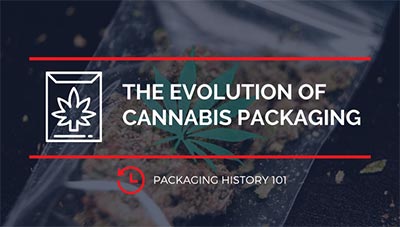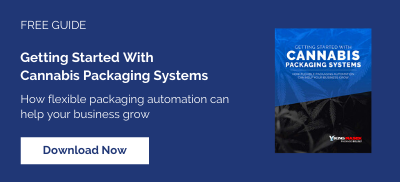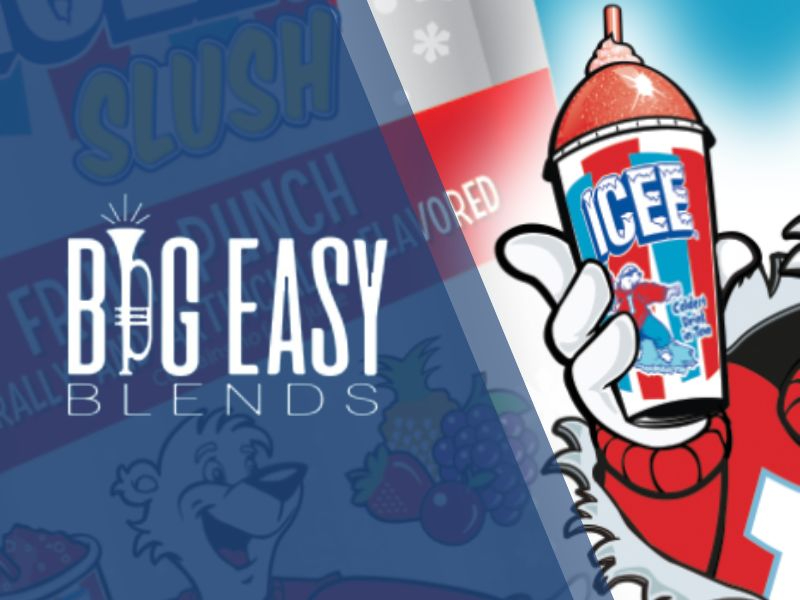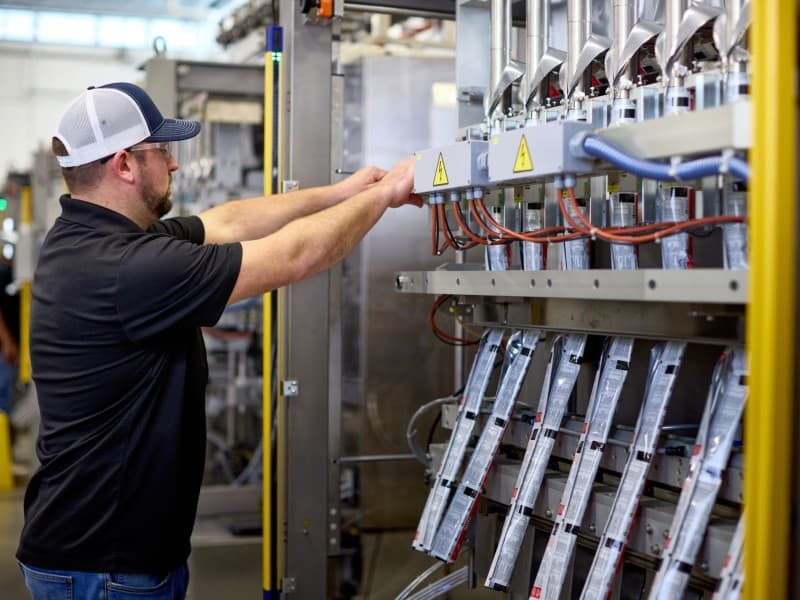Packaging history 101: The evolution of cannabis packaging
By Danielle Ohl on March 31, 2021

A naturally growing plant, cannabis has been around for much of recorded history. And boy, its history has been fraught and filled with controversy. But how (and where) did it all begin?
First used by humans to create rope in the third century BCE, cannabis was also discovered to have medicinal use. Emporer Chen Hung of China is considered one of the first to discover the healing properties of cannabis around 2700 BCE. From the Middle East to India to Greece and everywhere in between, cannabis was used as a treatment for conditions like leprosy, rheumatism, and opiate withdrawal.
It made its first appearance in North America in 1611, when Jonestown colonists brought the marijuana plant to America, making hemp fiber one of their most lucrative exports. Many historians say cannabis played a key role in the founding of the United States.
Since then, the role of cannabis in society has been a hot topic, to say the least.
Despite its controversial nature, cannabis is a quickly growing multi-billion dollar industry today. And without packaging, it would not be as successful as it is. From tins and jars to plastic baggies and premium pouches, the history of cannabis packaging is full of innovations, setbacks, discoveries, and controversies that have shaped its development over time.
So join us for Packaging History 101 and learn about the evolution of cannabis packaging! Chill...there won't be a test.
Want more packaging history and news? Subscribe for updates or check out other articles in our Packaging History 101 series: The evolution of coffee packaging - The evolution of snack packaging
Late 1800s - Early 1900s - Cannabis packaging firsts
 Mid-late 1800
Mid-late 1800
Way back when, cannabis was legally sold and used in the United States for medical purposes. Marijuana was originally packaged in airtight tin containers by pharmaceutical companies Park Davis & Company and S.B. Penick & Company (now Pfizer and Siegfried Ltd.). It was discovered that cannabis loses its potency if exposed to light for an extended period of time, so these containers were opaque.
1850 - early 1900
Now available for purchase at apothecaries and general stores, marijuana was packaged in glass or ceramic jars.
The 1900s - Beginning of the end
1906
The fun couldn't last forever. One of the first U.S laws pertaining to cannabis was drafted: The Pure Food and Drug Act. This regulated the labeling of products that contained cannabis, opiates, cocaine, and alcohol.
1907
With California leading the way, many states choose to classify cannabis products as poison (and label them as such).
1930 - 1960
During these years, a number of laws and regulations pass in the United States with the goal of regulating (and often demonizing) marijuana.
Notably, the Marihuana Tax Acct passes in 1937, using taxes to effectively make possession or transfer of marijuana illegal throughout the U.S., excluding cannabis for industrial or medical use.
 1970
1970
It's official. Cannabis products are criminalized as a Schedule 1 drug in the U.S. with the passing of the Controlled Substances Act, pushing their production, packaging, and use underground. Cheap, portable, and easy to buy, the resealable plastic baggie becomes the packaging of choice.
1980 - 1990
Penalties for marijuana offenses are increased in many states and at the federal level. Notably, mandatory sentencing and three-strikes pass in the mid-80s, leading to increased incarceration rates and steeper punishments for cannabis-related drug offenses.
Late 1900s - early 2000s - The push for legalization
1996
California was the first U.S state to label marijuana as a poison in 1907. Now, it does the opposite: With the passing of Proposition 215, California becomes the first U.S. state to legalize medical marijuana. It wasn't until 22 years later that California implemented a system to regulate these products. This meant that for many years, the market was a free-for-all, and so was cannabis packaging.
2012
Washington and Colorado become the first U.S. states to legalize recreational cannabis.
Packaging requirements are now more regulated, often including features like child-resistance, opacity, resealability, and tamper-evident seals.
2017
A growing market arises in the cannabis supply chain for a modified atmosphere packaging (MAP) solution called nitrogen gas flush. This packaging technology, already popular in the food industry, blasts the inside of a filled package with nitrogen shortly before sealing it shut. The goal is to displace oxygen, the main culprit of spoilage. This extends the shelf life and potency of the cannabis product sealed within.
As the future of the industry looks bright, cannabis companies begin to explore the possibilities of automating their packaging processes to keep up with demand and streamline operations.
2018
Canada becomes the first G-8 country to legalize cannabis nationwide, opening a brand new lucrative market. And with that, packaging questions to answer regarding regulation.
Because of the patchwork of laws governing packaging in U.S. states and federal laws still on the books prohibiting interstate commerce, large national packaging manufacturers have not really gotten involved in this market. This leaves room for smaller, niche packaging producers to thrive, producing creative, premium packaging that is tailored to their state or locality.
 2019
2019
Interest in cannabis packaging machines increases. Manufacturers need to scale up in a big way to keep up with demand, so their outdated, unreliable packaging processes need an upgrade.
Cannabis contract packagers show up on the market, offering specialized packaging services to cannabis companies that would rather outsource their packaging process altogether.
The market share of dried flower products sinks to 26% from 50% just 2 years prior. Instead, edibles grow in popularity as they are an easier, more discrete introduction to the product for new users than smoking a joint. Plastic pouches emerge as the preferred packaging type for edibles, with flexibles comprising about 43% of the market.
The 2020s - A maturing market...plus a pandemic
2020
Every marijuana initiative on the Nov. 3, 2020 ballot passes, legalizing marijuana for medical and/or recreational use in even more U.S. states. One-third of the population now lives in areas with legal recreational marijuana, and a whopping 70% of all states allow medical use.
With widespread legal availability of cannabis, its packaging has matured. No more clear plastic baggies. Instead, cannabis packaging features a premium, sophisticated look designed to destigmatize the product and appeal to consumers that probably never bought a sandwich baggie of weed.
The COVID-19 pandemic affects every industry, including cannabis. As consumers are told to socially distance, smaller packages of product became more popular as most began using at home either instead of in large groups. Additionally, because COVID-19 affects the lungs, inhaled cannabis products see a dip in demand, causing a resultant decrease in demand in packaging made for pre-rolls and joints.
With labor shortages and related issues exacerbated by the pandemic, cannabis manufacturers are increasingly likely to take the plunge into automating their packaging process. Pouch fill and seal machines emerge as one of the most popular packaging automation choices.
2021
Cannabis cultivation is notorious for being taxing on the environment. Additionally, strict cannabis packaging regulations often result in single-use packaging which creates more waste. As consumers demand more eco-responsibility, a focus on sustainable packaging strategies and materials is now top-of-mind for cannabis manufacturers.
Learn more about automated cannabis packaging
Want to automate the packaging of your cannabis product but don't know where to start? Just interested in learning more about cannabis packaging technologies? Download our free eBook: Getting Started with Cannabis Packaging Systems to get the scoop.

Sources:
MJ Wholesale - Marijuana Packaging History
Fresh Stash - History of Cannabis + Packaging
Weedmaps - Cannabis Packaging Comes a Long Way From the Sandwich Bag
What They Think - Cannabis Packaging Market to Triple in Three Years According to Smithers
Rolling Stone - America’s Boom in Illegal Weed
Related Posts

Delivering packaging excellence: How Big Easy Blends improved quality with packaging automation

Post-show clarity: Navigating the maze of packaging equipment options
